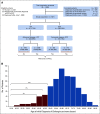The Cholangiocarcinoma in the Young (CITY) Study: Tumor Biology, Treatment Patterns, and Survival Outcomes in Adolescent Young Adults With Cholangiocarcinoma
- PMID: 37561981
- PMCID: PMC10581631
- DOI: 10.1200/PO.22.00594
The Cholangiocarcinoma in the Young (CITY) Study: Tumor Biology, Treatment Patterns, and Survival Outcomes in Adolescent Young Adults With Cholangiocarcinoma
Abstract
Purpose: Increased awareness of the distinct tumor biology for adolescents and young adults (AYAs) with cancer has led to improvement in outcomes for this population. However, in cholangiocarcinoma (CCA), a paucity of data exist on the AYA population. To our knowledge, we present the largest study to date on AYA disease biology, treatment patterns, and survival outcomes in CCA.
Methods: A multi-institutional cohort of patients with CCA diagnosed with intrahepatic cholangiocarcinoma (ICC) or extrahepatic cholangiocarcinoma (ECC) was used for analysis. Retrospective chart review was conducted on patients who were 50 years old and younger (young; n = 124) and older than 50 years (older; n = 723).
Results: Among 1,039 patients screened, 847 patients met eligibility (72% ICC, 28% ECC). Young patients had a larger median tumor size at resection compared with older patients (4.2 v 3.6 cm; P = .048), more commonly had N1 disease (65% v 43%; P = .040), and were more likely to receive adjuvant therapy (odds ratio, 4.0; 95% CI, 1.64 to 9.74). Tumors of young patients were more likely to harbor an FGFR2 fusion, BRAF mutation, or ATM mutation (P < .05 for each). Young patients were more likely to receive palliative systemic therapy (96% v 69%; P < .001), targeted therapy (23% v 8%; P < .001), and treatment on a clinical trial (31% v 19%; P = .004). Among patients who presented with advanced disease, young patients had a higher median overall survival compared with their older counterparts (17.7 v 13.5 months; 95% CI, 12.6 to 22.6 v 11.4 to 14.8; P = .049).
Conclusion: Young patients with CCA had more advanced disease at resection, more commonly received both adjuvant and palliative therapies, and demonstrated improved survival compared with older patients. Given the low clinical trial enrollment and poor outcomes among some AYA cancer populations, data to the contrary in CCA are highly encouraging.
Conflict of interest statement
The following represents disclosure information provided by authors of this manuscript. All relationships are considered compensated unless otherwise noted. Relationships are self-held unless noted. I = Immediate Family Member, Inst = My Institution. Relationships may not relate to the subject matter of this manuscript. For more information about ASCO's conflict of interest policy, please refer to
Open Payments is a public database containing information reported by companies about payments made to US-licensed physicians (
Figures




Similar articles
-
Molecular profiling and treatment pattern differences between intrahepatic and extrahepatic cholangiocarcinoma.J Natl Cancer Inst. 2023 Jul 6;115(7):870-880. doi: 10.1093/jnci/djad046. J Natl Cancer Inst. 2023. PMID: 37040087 Free PMC article.
-
Trends in Incidence and Factors Affecting Survival of Patients With Cholangiocarcinoma in the United States.J Natl Compr Canc Netw. 2018 Apr;16(4):370-376. doi: 10.6004/jnccn.2017.7056. J Natl Compr Canc Netw. 2018. PMID: 29632056
-
Effect of FGFR2 Alterations on Overall and Progression-Free Survival in Patients Receiving Systemic Therapy for Intrahepatic Cholangiocarcinoma.Target Oncol. 2022 Sep;17(5):517-527. doi: 10.1007/s11523-022-00906-w. Epub 2022 Sep 17. Target Oncol. 2022. PMID: 36114955 Free PMC article.
-
Viral hepatitis B and C infections increase the risks of intrahepatic and extrahepatic cholangiocarcinoma: Evidence from a systematic review and meta-analysis.Turk J Gastroenterol. 2020 Mar;31(3):246-256. doi: 10.5152/tjg.2020.19056. Turk J Gastroenterol. 2020. PMID: 32343237 Free PMC article.
-
Future directions in the treatment of cholangiocarcinoma.Best Pract Res Clin Gastroenterol. 2015 Apr;29(2):355-61. doi: 10.1016/j.bpg.2015.02.010. Epub 2015 Feb 19. Best Pract Res Clin Gastroenterol. 2015. PMID: 25966434 Review.
Cited by
-
Exceptional sustained long-term complete response to Tepotinib in a MET-amplified advanced intrahepatic biliary tract cancer failing Durvalumab plus Cisplatin and Gemcitabine.Oncologist. 2024 Dec 6;29(12):1090-1094. doi: 10.1093/oncolo/oyae265. Oncologist. 2024. PMID: 39356253 Free PMC article.
-
Impact of Bone Metastases and Actionable Genetic Alterations in Biliary Tract Cancer.Cancers (Basel). 2025 May 12;17(10):1639. doi: 10.3390/cancers17101639. Cancers (Basel). 2025. PMID: 40427137 Free PMC article.
-
Survival Analysis of Metastatic Young-Onset vs. Average-Onset Cholangiocarcinoma: A Population-Based Study.Asian Pac J Cancer Prev. 2025 May 1;26(5):1823-1830. doi: 10.31557/APJCP.2025.26.5.1823. Asian Pac J Cancer Prev. 2025. PMID: 40439396 Free PMC article.
References
-
- Sung H, Siegel RL, Rosenberg PS, et al. Emerging cancer trends among young adults in the USA: Analysis of a population-based cancer registry. Lancet Public Health. 2019;4:e137–e147. - PubMed
-
- Bleyer A, Barr R, Ries L, et al. Cancer in Adolescents and Young Adults. Cham, Springer International Publishing AG; 2017.
Publication types
MeSH terms
Grants and funding
LinkOut - more resources
Full Text Sources
Medical
Research Materials
Miscellaneous

